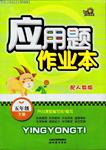题目内容
“Tear’ em apart!” “Kill the fool!” “Murder the referee (裁判)!”
These are common remarks one may hear at various sporting events. At the time they are made, they may seem innocent enough. But let’s not kid ourselves. They have been known to influence behavior in such a way as to lead to real bloodshed. Volumes have been written about the way words affect us. It has been shown that words having certain connotations (含义) may cause us to react in ways quite foreign to what we consider to be our usual humanistic behavior. I see the term “opponent” as one of those words. Perhaps the time has come to delete it from sports terms.
The dictionary meaning of the term “opponent” is “adversary” “enemy”; “one who opposes your interests.” Thus, when a player meets an opponent, he or she may tend to treat that opponent as an enemy. At such times, winning may dominate one’s intellect, and every action, no matter how gross, may be considered justifiable. I recall an incident in a handball game when a referee refused a player’s request for a time out for a glove change because he did not consider them wet enough. The player proceeded to rub his gloves across his wet T-shirt and then exclaimed. “Are they wet enough now?”
In the heat of battle, players have been observed to throw themselves across the court without considering the consequences that such a move might have on anyone in their way. I have also witnessed a player reacting to his opponent’s international and illegal blocking by deliberately hitting him with the ball as hard as he could during the course of play. Off the court, they are good friends. Does that make any sense? It certainly gives proof of a court attitude which departs from normal behavior.
Therefore, I believe it is time we elevated (提升) the game to the level where it belongs there by setting an example to the rest of the sporting world. Replacing the term “opponent” with “associate” could be an ideal way to start.
The dictionary meaning of the term “associate” is “colleague”; “friend”; “companion.” Reflect a moment! You may soon see and possibly feel the difference in your reaction to the term “associate” rather than “opponent.”
1.Which of the following statements best expresses the author’s view?
A. Aggressive behavior in sports can have serious consequences.
B. The words people use can influence their behavior.
C. Unpleasant words in sports are often used by foreign athletes.
D. Unfair judgments by referees will lead to violence on the sports field.
2.Harsh words are spoken during games because the players ________.
A. are too eager to win
B. are usually short-tempered and easily offended
C. cannot afford to be polite in fierce competition
D. treat their rivals as enemies
3.What did the handball player do when he was not allowed a time out to change his gloves?
A. He refused to continue the game.
B. He angrily hit the referee with a ball.
C. He claimed that the referee was unfair.
D. He wet his gloves by rubbing them across his T-shirt.
4.According to the passage, players, in a game, may ________.
A. deliberately throw the ball at anyone illegally blocking their way
B. keep on screaming and shouting throughout the game
C. lie down on the ground as an act of protest
D. kick the ball across the court with force
5.The author hopes to have the current situation in sports improved by ________.
A. calling on players to use clean language on the court
B. raising the referee’s sense of responsibility
C. changing the attitude of players on the sports field
D. regulating the relationship between players and referees
1.B
2.D
3.D
4.A
5.C
【解析】
试题分析:这是一篇论述文,由赛场上一些评论言语对运动员行为上的影响实例来论述带某些含义的词语会使人偏离正常的人道主义行为。
1. having certain connotations may…our usual humanistic behavior”带有某种含义的词可使我们反应的方式不同于我们通常人道主义行为方式。换言之,人们使用的词语影响他们的行为。故选B。
2. a payer meets an opponent,he or she tend to treat that opponent as an enemy.”在比赛中运动员往往把对手视为敌人。故可知选D。
3. player proceeded to rub his glove across his wet T-shirt”选手继续在湿的T恤上擦拭他的手套,可知选D。
4.
5. certainly gives proof of a court attitude which departs from nomal behavior”,当前球场形式是:球场态度背离正常行为。故选项C“改变运动员在运动赛场上的态度”是解决途径。故选C。
考点:考查论述文阅读理解。

 应用题作业本系列答案
应用题作业本系列答案